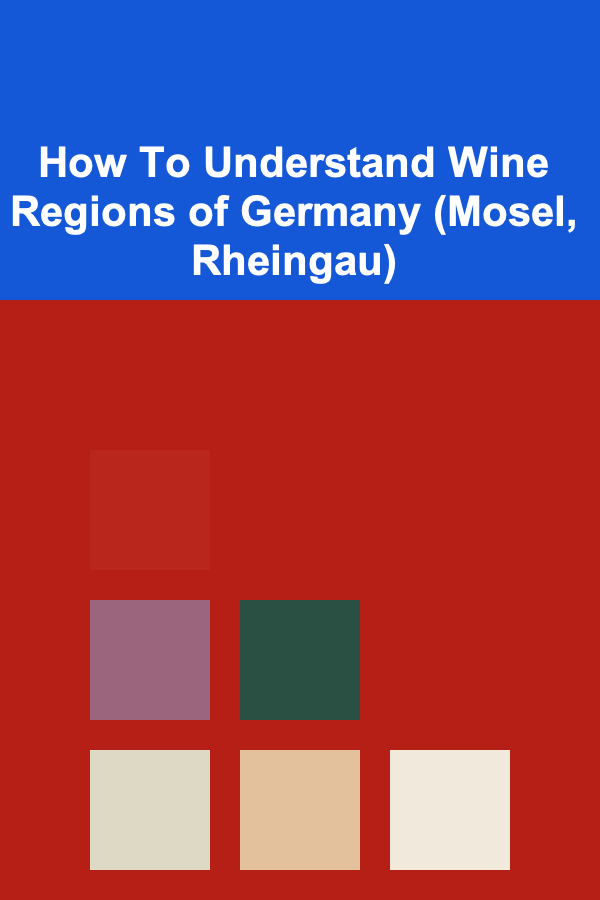
How To Understand Wine Regions of Germany (Mosel, Rheingau)
ebook include PDF & Audio bundle (Micro Guide)
$12.99$10.99
Limited Time Offer! Order within the next:

Germany is known for its rich winemaking tradition and diverse wine regions. Among the most celebrated and renowned wine regions in Germany are Mosel and Rheingau. These two regions offer unique terroirs, distinct wine styles, and centuries of winemaking history that have shaped their international recognition. Understanding the nuances of these regions can enhance one's appreciation for German wines and deepen knowledge of the subtleties of German viticulture.
In this article, we will explore the key elements that make the Mosel and Rheingau wine regions exceptional, from their climate and geography to their grape varieties, winemaking techniques, and the wines that define these regions.
Mosel: A Region Defined by Rivers and Slopes
Geography and Climate
The Mosel wine region is located in western Germany, nestled along the Mosel River, which winds through the steep and often rugged hills of the region. The Mosel is one of the most visually stunning wine regions in the world, characterized by terraced vineyards that seem to cling to the slopes of the hills. The region covers a relatively small area, yet it is home to some of the finest Riesling wines in the world.
The climate in Mosel is classified as cool, which plays a crucial role in the types of grapes that thrive in this region. The cool climate results in slow grape ripening, allowing the wines to maintain their high acidity, which is a hallmark of Mosel wines. The proximity to the river helps moderate the temperatures, preventing frost and providing additional warmth during the growing season, but the vines still struggle to ripen fully in some years, leading to a characteristic lightness in the wines.
Terroir and Soils
The terroir of Mosel is extremely varied due to the complex interplay of river influences, steep slopes, and soils. The slopes facing south and southwest are particularly well-suited for growing Riesling, the region's most famous grape variety. The soils in Mosel are primarily slate-based, which is responsible for the region's unique terroir. Slate is a heat-retaining stone, which helps to warm the vines during the cooler nights, promoting better ripening of the grapes.
In addition to slate, the region also has a variety of soils, including quartzite, clay, and loess. Each soil type adds different characteristics to the wine, but it is the slate that is most strongly associated with the Mosel's exceptional wines. The slate soils provide excellent drainage, ensuring that the vines' roots are not waterlogged, which would otherwise lead to poor-quality wines.
Grapes and Wine Styles
While the Mosel is primarily known for its Riesling, other grape varieties are grown here, including Pinot Noir (Spätburgunder), Müller-Thurgau, and Elbling. However, Riesling is undoubtedly the star of the show. This grape thrives in the Mosel's cool climate and steep slopes, resulting in wines with vibrant acidity and refreshing citrus flavors. The wines produced in Mosel are often lighter in body compared to other regions in Germany, making them more approachable for those new to wine.
Riesling wines from Mosel come in a variety of styles, ranging from bone-dry to intensely sweet. The sweetness levels of Mosel Rieslings are typically classified according to the Prädikatswein system, which includes categories such as Kabinett (light and dry), Spätlese (late harvest), Auslese (select harvest), and more. Each of these categories corresponds to the level of ripeness of the grapes and the resulting sweetness of the wine.
In addition to Riesling, the region is gaining attention for its Pinot Noir wines, which are typically light and fruity, with bright red berry flavors. These wines are often made in a more delicate style, with minimal oak influence, allowing the fruit to shine.
Mosel Wine Producers
Some of the most notable producers in Mosel include Weingut Dr. Loosen , Weingut Egon Müller , and Weingut Markus Molitor. These producers have helped elevate the region's reputation and showcase the exceptional potential of Riesling. Many of these producers have adopted organic and biodynamic practices, focusing on sustainability and preserving the natural qualities of their vineyards.
Rheingau: A Classic Region with Rich History
Geography and Climate
The Rheingau wine region is located in the heart of Germany's wine country, along the banks of the Rhine River, in the state of Hesse. The region's geographical location and its proximity to the river contribute to the region's mild climate, which is slightly warmer than that of the Mosel. The area is also protected by the Taunus mountain range to the north, which creates a kind of "rain shadow," shielding the vineyards from excessive rainfall and allowing for more reliable growing conditions.
Rheingau has a continental climate, with cold winters and warm summers. The vineyards are often located on slopes that face south and southwest, providing optimal sunlight exposure for ripening the grapes. The region also benefits from the Rhine River, which moderates the temperatures and helps prevent frost damage.
Terroir and Soils
The terroir of Rheingau is diverse, with a combination of soils that vary from steep, terraced slopes near the river to flatter areas further inland. The soils of Rheingau are primarily composed of a mix of slate, quartzite, loess, and clay, with some vineyards even boasting rich deposits of limestone.
The warm, sunny climate combined with the rich soils produces wines that are fuller-bodied than those from the Mosel. The wines from Rheingau are known for their balance of acidity, fruitiness, and subtle mineral qualities. The region's terroir is ideal for the production of both Riesling and Pinot Noir, though Riesling is the dominant grape variety.
Grapes and Wine Styles
Rheingau is most famous for its exceptional Riesling wines, which are considered some of the finest in the world. These wines are known for their balance of richness and acidity, with notes of citrus, green apple, and sometimes hints of honey and petrol. Rheingau Rieslings are generally less sweet than those from Mosel, with a focus on dry and off-dry styles, making them perfect companions for a wide range of dishes.
In addition to Riesling, the region is also known for its production of high-quality Pinot Noir (Spätburgunder), which thrives in the warmer climate of Rheingau. These wines are typically more structured and fuller-bodied than those from the Mosel, with ripe red fruit flavors, soft tannins, and subtle oak influence.
Rheingau also produces a range of other white wines, including Chardonnay and Silvaner, although these are less common than Riesling. These wines are often made in a more modern, international style, with a focus on freshness and drinkability.
Rheingau Wine Producers
Some of the most notable producers in Rheingau include Weingut Robert Weil , Weingut Georg Breuer , and Weingut Kloster Eberbach. These producers have earned international acclaim for their commitment to quality and their innovative approach to winemaking. Many Rheingau producers have also adopted organic and sustainable farming practices, working to preserve the region's natural beauty while producing exceptional wines.
Comparison of Mosel and Rheingau
While both Mosel and Rheingau are world-renowned wine regions in Germany, they offer distinct differences in climate, terroir, and winemaking traditions. The Mosel is known for its cooler climate, steep slopes, and lighter, more delicate wines, primarily focused on Riesling. In contrast, Rheingau has a warmer climate, more varied soils, and a wider range of wine styles, with an emphasis on dry and off-dry Rieslings as well as high-quality Pinot Noir.
The wines from Mosel tend to have higher acidity and a lighter body, with a distinct minerality driven by the slate soils. These wines often have a sense of freshness and elegance. On the other hand, Rheingau wines are typically fuller-bodied, with a rounder mouthfeel and a more pronounced fruitiness. They are often more approachable in their youth, although the best wines from Rheingau can age gracefully for many years.
Similarities
- Both regions are home to world-class Riesling wines.
- Both Mosel and Rheingau produce wines with a strong sense of place, reflecting their unique terroirs.
- The winemaking traditions in both regions are steeped in history and have been passed down through generations.
- Both regions are home to some of Germany's most prestigious wine producers.
Differences
- Mosel is cooler and more challenging for growers, resulting in lighter, more delicate wines.
- Rheingau has a warmer climate, producing wines that are often fuller-bodied and more structured.
- Mosel wines are typically more focused on sweetness, while Rheingau wines are often produced in drier styles.
Conclusion
Germany's Mosel and Rheingau wine regions are both exceptional in their own right, offering distinct wines that reflect the unique terroirs and climates of each area. Mosel, with its steep slopes, slate soils, and cooler climate, is best known for its elegant and high-acid Rieslings. Rheingau, with its warmer climate and diverse soils, is famous for its dry Rieslings and world-class Pinot Noir.
Whether you prefer the crisp, minerally wines of Mosel or the richer, more structured wines of Rheingau, both regions offer something for every wine lover to explore and appreciate. Understanding the differences between these two iconic regions is the first step in developing a deeper appreciation for German wines and the rich history of winemaking in this beautiful country.

How To Build Your Child's Inner Strength
Read More
How to Makeover Your Living Room with Discount Fabrics
Read More
How to Use Vertical Space for Enhanced Workspace Organization
Read More
The Marketing Specialist's Toolkit: Best Practices for Driving Brand Growth
Read More
How to Understand Craft Beer Sensory Analysis
Read More
How to Implement Blockchain for Smart Energy Grids
Read MoreOther Products

How To Build Your Child's Inner Strength
Read More
How to Makeover Your Living Room with Discount Fabrics
Read More
How to Use Vertical Space for Enhanced Workspace Organization
Read More
The Marketing Specialist's Toolkit: Best Practices for Driving Brand Growth
Read More
How to Understand Craft Beer Sensory Analysis
Read More